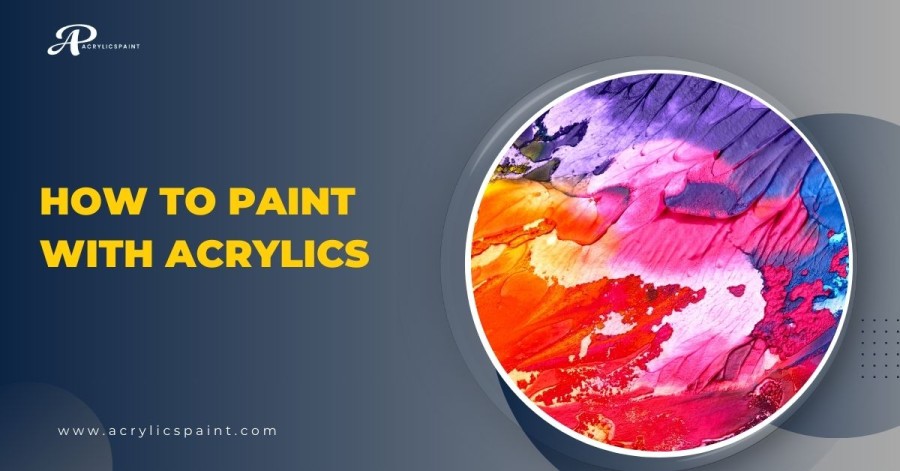How to paint with acrylics? – Have you ever been captivated by a vibrant acrylic painting, its colors bursting with life? You may have seen stunning landscapes or captivating abstracts rendered in this versatile medium. The question “How to paint with acrylics?” can confuse you, but know that the beauty of art is that there’s no right or wrong way to begin. Well, guess what? You, too, can create your masterpieces with acrylics! This guide will equip you with the acrylic painting basics and How to paint with acrylics? you need to start your artistic journey.
Gather Your Supplies
Prior to beginning, it’s crucial to possess the appropriate equipment. Here’s a basic rundown of what you’ll need:
Types of Craft Paint
Acrylic paint reigns supreme for beginners as they are water-soluble, dries quickly, and offers vibrant colors. You can also use oil-based paints, heavy-body and light-body paints, and watercolors.
Acrylic Paint Art Set
A starter set with a selection of primary and secondary colors, black and white, is a great starting point. As you progress, you can expand your palette.
Brushes
Invest in a good set of synthetic brushes with various sizes and shapes. Flat brushes are ideal for covering large areas, while round brushes excel in detail work.
Canvas or Paper
- Start by practicing canvas painting techniques on inexpensive canvases. As you become more familiar with it, consider using acrylic paint on paper, which is a more transportable choice. For best results, choose heavyweight paper specifically designed for acrylics.
Other essentials
A palette (a flat surface for mixing paints), a cup for water, rags or paper towels for cleaning, and a smock (optional but highly recommended!)
Start With Simple Techniques
Now that you have all the necessary supplies let’s explore some fundamental acrylic painting techniques for beginners:
Flat Wash
This is a great way to lay down a base color or create backgrounds. Dilute your paint with water and apply it in even strokes across your canvas.
Layering
Build depth and richness by layering thinned-down washes of paint, letting each layer dry before adding the next.
Glazing
Similar to layering, glazing involves applying thin, transparent layers of paint to create subtle color variations and depth.
Blending
Create smooth transitions between colors by blending them while wet with a damp brush. Experiment with different brushstrokes for varied effects.
Dry Brushing
Apply paint with a nearly dry brush for textured effects. This technique is perfect for highlighting raised areas or creating a weathered look.
How To Shade With Acrylic Paints
Light and shadow define form and depth in a painting. Mastering acrylic paint shading takes your artwork to a whole new level:
Identify Your Light Source
Decide where the light is coming from in your painting. This will determine where you place your highlights and shadows.
Highlighting
Use lighter shades of your base color or white to create areas hit by the light.
Shading
Use darker shades of your base color or black to depict areas in shadow. Remember, shadows are not just black – they often contain hints of the surrounding colors.
How to Add Dimension
Acrylics offer fantastic acrylic texture techniques to add visual interest and tactile dimension to your artwork:
Impasto
Mix your paint with a medium-like acrylic modeling paste to create thick, raised textures. Great for creating bold brushstrokes or adding a sculptural element.
Sand/Grit
To achieve a grainy texture, scatter sand or grit over your damp paint. Let the sand dry, then gently brush off the excess.
Scumbling
This technique involves applying light, broken paint strokes in a circular motion. It creates a textured overlay on your base color.
Painting Options You Can Try
Here are some additional acrylic paint uses to spark your creativity:
Abstract Painting
Embrace your creativity and let go of any inhibitions as you dive into the world of abstract art. Experiment with vibrant colors, bold brush strokes, and unique textures to create a piece that truly reflects your inner artist. Abstract art allows for complete freedom of expression, with no limitations or rules to hold you back.
Let your imagination run wild and see where it takes you as you explore the endless possibilities of this dynamic and exciting art form. Whether you’re a seasoned artist or just starting, abstract art is the perfect way to unleash your creativity and create something truly original and unique. So go ahead, let loose, and see where your artistic journey takes you!
Mixed Media
Combine acrylics with other mediums like collages, markers, or fabric scraps to create unique and layered artworks.
Customizing Objects
Give new life to old furniture, shoes, or even phone cases by painting them with acrylics.
Pour Painting
This mesmerizing technique involves pouring thinned-down acrylics directly onto your canvas. The way the paints flow and blend creates stunning organic patterns.
Fluid Art
Like pour painting, fluid art utilizes a variety of mediums to create dynamic and colorful effects on your canvas. Explore methods such as swipe art, string dragging, and messy pouring.
Color Field Painting
This technique focuses on creating large areas of flat color, often with subtle variations within the same hue.
How to paint with acrylics? Practice Makes Perfect!
Now that you have the basics down for How to paint with acrylics?, here are some ways to refine your skills and keep the creative juices flowing:
- Practice, Practice, Practice. Like any skill, mastering acrylic painting takes time and dedication. Set aside time to experiment, make mistakes (they’re learning opportunities!), and have fun!
- Learning from experienced artists can be invaluable. Consider enrolling in a beginner-friendly acrylic painting class or workshop.
- The internet is a treasure trove of tutorials, demonstrations, and inspiration for acrylic painting. Explore online courses, watch YouTube: acrylic painting techniques, and follow artists you admire on social media.
- Connect with other aspiring artists by joining a local art club or online forum. Sharing your work and receiving feedback can be incredibly motivating.
Conclusion
How to paint with acrylics? The world of acrylic painting is brimming with possibilities. Whether you’re attracted to lifelike landscapes, fascinating abstracts, or something completely unique, acrylics provide the vividness to make your imagination come alive. Remember, there are no mistakes in art – only happy accidents and opportunities for learning. So embrace the journey, have fun experimenting, and let your creativity flow! With each brushstroke, you’ll discover the immense satisfaction and joy of creating your artistic masterpiece.













